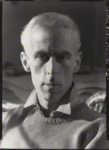
John Piper
British, 1903-1992
Ruins of a Cottage in North Wales, 1940
pen and ink, watercolor, gouache, pastel on paper
16 3/4 x 20 1/2 in.
SBMA, Gift of Wright S. Ludington
1947.13.7

by Howard Coster, half-plate film negative, 1946
COMMENTS
John Piper’s career in art spanned over sixty years and has incorporated a huge range of artistic media including printmaking, painting, drawing and illustration, photography, stained glass, fabric design, murals, stage sets and costume design. However, Piper is most well known for his prints and paintings of the romantic heritage of Britain; his explorations of rural Britain throughout his life (a passion that started with bicycle adventures in his native Surrey as a boy) have much influence on his paintings. Piper developed a fascination with vernacular and ecclesiastical architecture. In his prints, his subject matter was predominately architectural; often abbeys, churches, houses, castles, cottages or details of architectural design . His style comes both from his English heritage and his commitment to the emergent modern and abstract movements that were developing as he left art school. Dramatic, romantic combinations of colour, calligraphic line and experimental textures are the tenets of his oeuvre.
Piper was taught at Epsom College, and then trained at the Richmond School of Art and later the Royal College of Art in London (1926-28). After this, he went on to write art criticism for the Listener and the Nation, and was among the first to recognise such contemporaries as William Coldstream, Ivon Hitchens, Victor Pasmore and Ceri Richards. During the 1930s, under the influence of Ben Nicholson and the St. Ive’s group, Piper flirted with abstraction- leading to the foundation of ‘Axis’ magazine (which advocated abstract art) with his wife Myfanwy.
During World War II, John Piper was appointed as an official war artist. He was tasked with recording the effects of the blitz on Britain’s buildings. After producing a series of drawings of Windsor Castle for H. M the Queen at the time, his work picked up interest at an increasing rate. After the war, he became a Trustee at the Tate Gallery and National Gallery and then in 1959 he became a member of the Royal Fine Art Commission.
John Piper also created – and is well known for - a stained glass window for Coventry Cathedral; the windows for Eton College Chapel and alongside Patrick Reyntiens, for Liverpool’s Roman Catholic Cathedral. He is also known for his work in the graphics field, having started Contemporary Lithographs back in 1936. In 1964, the best known “A Retrospect of Churches” lithograph was produced. Also in the 1960s, he took an interest in screenprinting and etching, alongside Chris Prater at Kelpra Studio. In 1983 the Tate staged a full retrospective of his work.
John Piper passed away in Buckinghamshire on 28 June 1992, his children follow in his footsteps as artists and painters.
http://www.ccagalleries.com/artists/john-piper
According to the artist, he made this drawing in 1940 of the ruins of a cottage near Trawsfynnydd in the parish of Maentwrog, in central Wales. It was very close to an earth mound called Tomen-y-mur, all which remained of an ancient Roman fort. The ominous mood was perhaps prescient, because when the artist returned to the site in 1971 he found no vestige of the ruined cottage, the stones presumably used by local farmers for walls or other buildings. Such ruins are no strangers to Piper’s oeuvre; he has drawn architectural studies all over England and Western Europe, not only of living monuments like Windsor Castle and San Marco in Venice, but also of the melancholic remains of once-mighty works now in despair.
- From SBMA flies December 1972. The artist was alive and living in Henley. Purchased from Buchholz Gallery, New York.
SBMA CURATORIAL LABELS
Although always intent on becoming an artist, at his father’s insistence Piper had to enter the family law firm in London. It was only after his father’s death that he was able to renounce the law and study art full time, first at Richmond School of Art and then at London’s Royal College of Art, which he left without taking his Diploma. From an early age he had a strong fascination with early church architecture and stained glass, but as an ambitious young artist he was anxious to be part of the avant garde, and throughout most of the 1930s produced only non-figurative works. In 1935 helped his future wife, Myfanwy, launch Axis, a quarterly review of ‘Contemporary “Abstract” Painting and Sculpture’. By the end of the decade, however, he had reverted to his first love and for the rest of his life produced watercolors and oil paintings of highly-charged romantic buildings and landscapes. As an Official War Artist he produced poignant images of bombed buildings, especially Coventry Cathedral and St Mary’s Redcliffe, Bristol.
- British Modernism from Whistler to WWII, 2016
